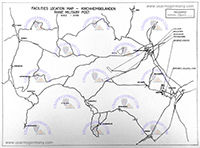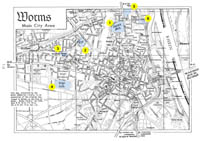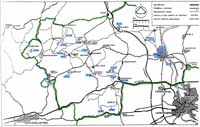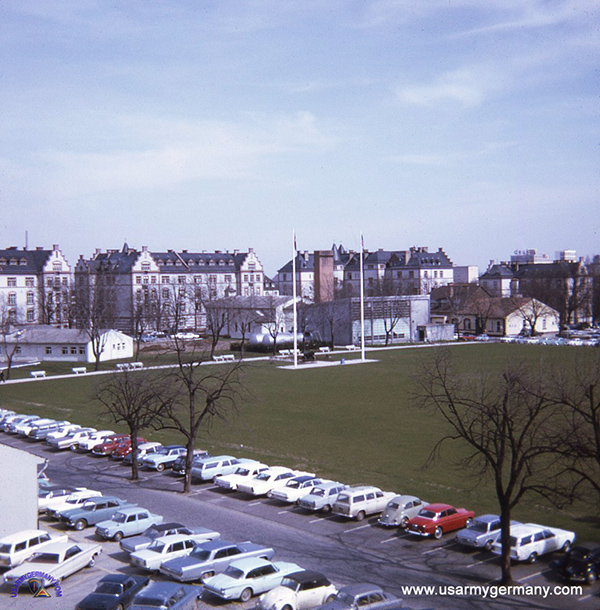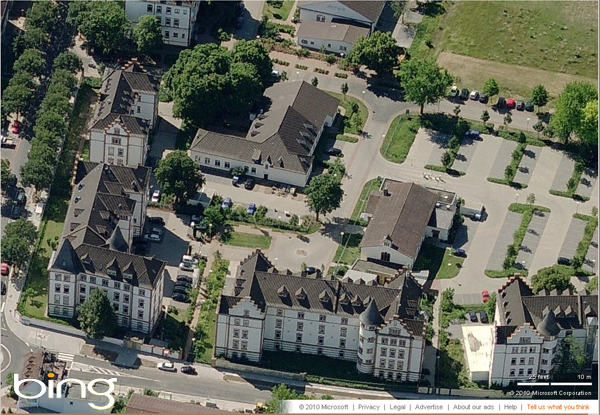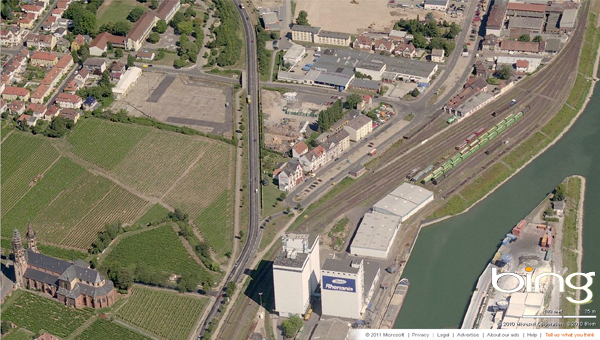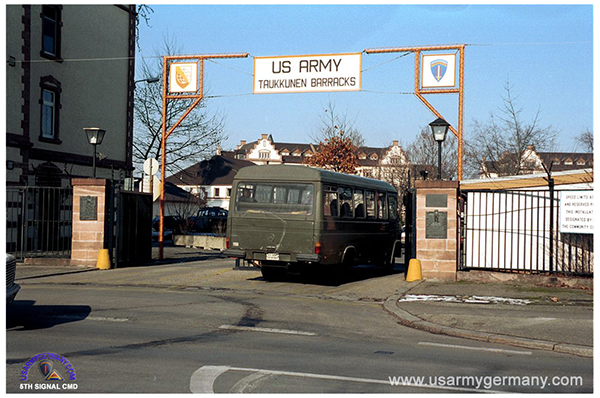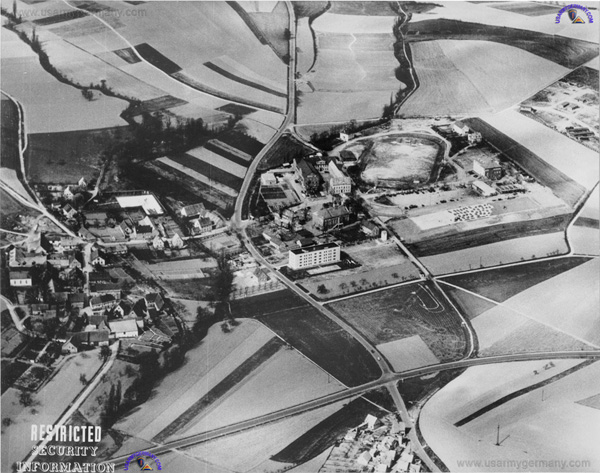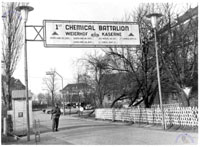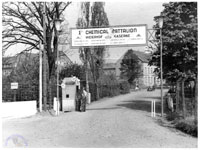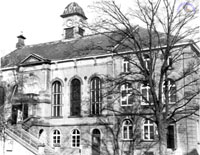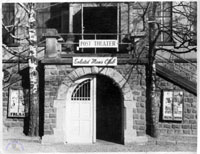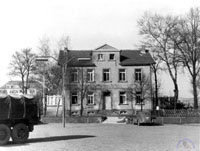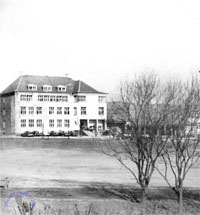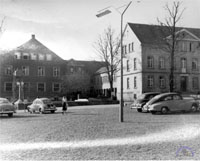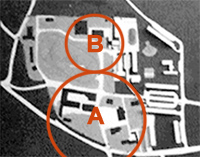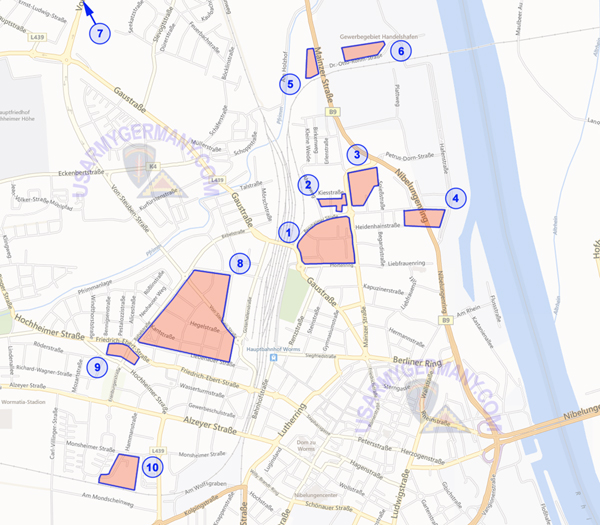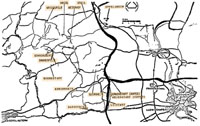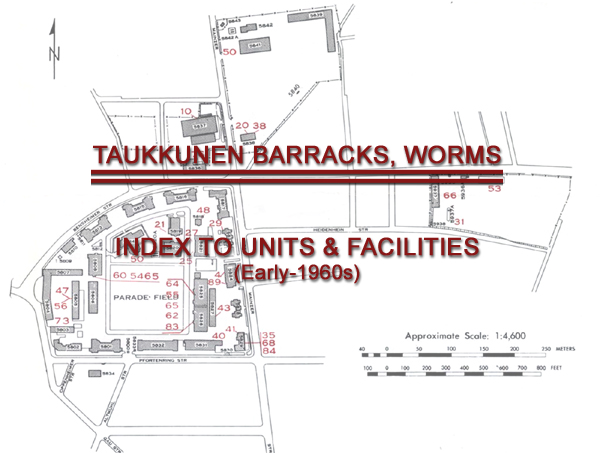Click here to open 'USArmyGermany' frameset
DE LA POLICE BARRACKS |
||
ENGINEER KASERNE |
NORTH POINT DEPOT |
|
GRÜNSTADT ARMY DEPOT |
| MAPS |
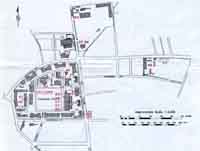 1. Taukkunen Kaserne |
 2. De La Police Kaserne |
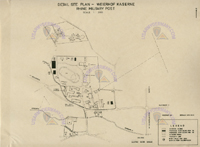 3. Weierhof Kaserne |
| 1951 Facilities location map for Kirchheimbolanden and surrounding area. (In official documents of the period Weierhof was usually identified as "Marnheim"). Click on the thumbnail to view a larger format of the same map. |
 |
|
| 1980 Topographical maps of Worms and surrounding area. These maps are reproduced from the "U.S. Military Installation Atlas" published by the 37th Transportation Group in 1980. Click on the thumbnail to view a larger format of the same map. Click here for a list of the installations. |
 |
|
| 1980 Map showing U.S. installations within Worms City. Click on the thumbnail to view a larger format of the same map. INSTALLATIONS: 1. Taukkunen Barracks 2. Thomas Jefferson Village 3. Police Kaserne 4. Engineer Kaserne 5. Motor Pool 6. Auto Crafts Shop area |
||
| Early
1980s Map showing remote sites within the Worms Military Community area of responsibility. Click on the thumbnail to view a larger format of the same map. Click here for a list of the installations. |
|
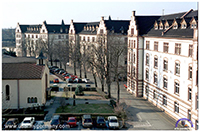 1. Taukkunen Bks, 1996 |
||||
|
||||
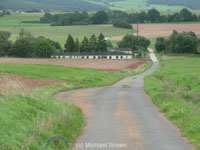 1. The radio station with Lohnsfeld on the far left (KB) |
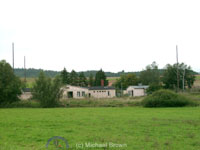 2. View from road coming from Lohnsfeld (KB) |
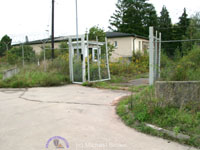 3. Site gate (KB) |
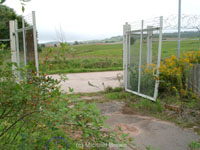 4. Looking west (KB) |
|
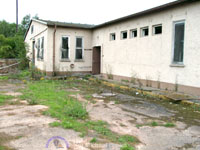 5. Main building (KB) |
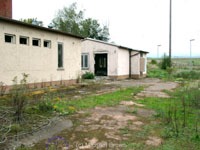 6. Generator building (KB) |
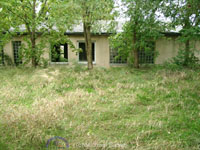 7. Sleeping quarters (KB) |
||
|
More of George Payne's photos can be seen on his brother's website. |
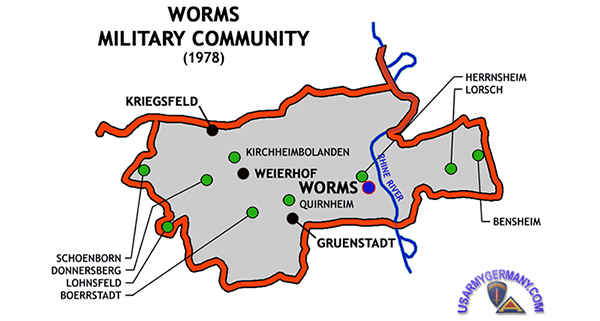
| The Worms Military Community is located on the northern edge of Worms. Overall, six installations make up the Community with Taukkunen Barracks and Thomas Jefferson Village as the two major installations. The four other installations are the Engineer Kaserne, Motor Pool, La Police Kaserne and the Auto Crafts Shop area. A BIT OF TAUKKUNEN BARRACKS HISTORY Taukkunen Barracks is the hub of the Community where 95 percent of the American workforce are located during duty hours. The installation was built by the Germans in 1897 and was first known as "Kaserne 118", named for the 118th Infantry Regiment stationed here before World War I. During World War II the name was changed to "Kemmel Kaserne" in commemoration of the Kemmel Battlefield near Arras, France. The name was changed again after the war to "Foch Kaserne" in honor of French General Foch who, at the time, was the Supreme Commander of the Allied Forces. The kaserne was renamed "Taukkunen Barracks" in 1956 for U. S. Army Staff Sergeant Ernest Taukkunen who was assigned to the 41st Armored Infantry Regiment, 2d Armored Division. SSG Taukkunen was posthumously decorated with the Distinguished Service Cross for heroic accomplishments during WW II. In less than 100 years Taukkunen Barracks has garrisoned soldiers of the German, French, and United States armies. Among the many U. S. Army units that have been garrisoned in Worms, two major Army commands have been headquartered here since U. S. Forces obtained area jurisdiction. The U. S. Theater Army Support Command, Europe (TASCOM) was headquartered here from April 1967 until June 1974 when the U. S. Army Strategic Communications Command, Europe (STRATCOM) relocated from Schwetzingen, Germany and was redesignated Headquarters, 5th Signal Command, a subordinate unit of the U. S. Army Communications Command. THOMAS JEFFERSON VILLAGE The family housing area and bachelor officers' quarters are located in Thomas Jefferson Village. Commonly referred to as "TJV" or "The Village", the residential area is a village in every sense of the word. The Village is located less than half a mile from Taukkunen Barracks and is about a 10-15 minute walk from Taukkunen. Many facilities such as the commissary, Army Community Services Center and the TJV Nursery are conveniently located in the Community Building on the corner of Bebelstrasse and Von Steuben Strasse. Also located in TJV is the Worms Officers' and Civilians' Open Mess and the Dependent Youth Activities Center, as well as the Worms American Elementary School. LA POLICE KASERNE This kaserne is located between the streets of Erenburger, Liebenauer and Hochheimer and houses a signal support center and the American Preschool. The Worms City Police occupied the kaserne until WW II when the French Army moved in and renamed it "La Police Kaserne". In July 1951 the U. S. Army arrived and took over the kaserne. ENGINEER KASERNE The Engineer Kaserne was built in October 1954 as a model kaserne for all other engineer facilities on military installations throughout Europe. It was built at its location because of the proximity to the railroad and coal yard, which are no longer used. THE WEIERHOF/NORTH POINT SUBCOMMUNITY The Weierhof/North Point subcommunity became a part of the Worms military community in 1976. A BIT OF WEIERHOF/NORTH POINT HISTORY The Weierhof housing area was built in the late 1940s. Although there are no official documents to verify the story, it is said that General George Patton and his troops were one of the first U. S. Army units to stay in Weierhof during World War II. At the end of the war, American forces were given confiscation rights and subsequently claimed the Weierhof school which was used as a German Army training school prior to and during WW II. In 1954 an agreement was made between the U. S. Army and German officials to return the school to the city of Weierhof in exchange for constructing permanent quarters and recreational facilities at the Kriegsfeld Army Depot (North Point). Construction work was initiated on the depot in 1954 and was completed in March, 1955. Married personnel reside in quarters at Weierhof or on the local economy, and single enlisted personnel have billeting accommodations on the depot. |
| Worms facilities bring added diversity to Milcom by Staff Sgt. Bob Baldi The consolidation of the Mannheim and Worms military communities has brought many new units, personnel and facilities to the Mannheim Military Community. Located entirely within the German Federal State of Rheinland Pfalz, the Worms Military Community encompassed 15 units and 28 separate installations within a geographical region of 525 square miles. Approximately 7,500 soldiers, family members and civilian employees compose what was formally the Worms Military Community. Roughly one half of the population resides in the immediate vicinity of the City of Worms. The remainder live and work in the Weierhof Sub-Community or one of its 12 remote sites. The major installation in Worms proper is Taukkunen Barracks, host to the 5th Signal Command Headquarters and several other smaller elements. A small installation, Taukkunen Barracks has limited support activities such as a small exchange, pick-up point, garage, Class Six store, NCO-EM Club, gymnasium and bowling alley. The commissary, bank, outdoor recreation, Officers and Civilians Club and additional exchange facilities are located at Thomas Jefferson Village, the community's largest military housing area. Aside from Thomas Jefferson Village. or TJV as it is known to area residents, there are several leased housing areas spread throughout the region, including Osthofen, Rheinduerkheim, Monsheim, Albisheim and Einselthum. The Weierhof Sub-Community is located approximately 30 kilometers west of the City of Worms. It is the area's second largest housing area, hosting such additional activities as a dental clinic, post office, small exchange, craft shop, library, transit billets, youth activity and a community club. The Weierhof Sub-Community supports logistical needs for numerous air defense, communications and ordnance units located at remote sites. The largest of the isolated sites is Kriegsfeld Ammunition Depot, also known as North Point. North Point hosts two ordnance and one military police company. The sprawling site offers a gymnasium, a barbershop-bookstore, a small exchange, a library, a video rental concession, a recreation center and an all-ranks community club. At the other end of the spectrum, sites such as Austin Relay and Lohnsfeld offer very limited amenities and are characterized by their extremely isolated locations. In addition to the government-owned housing in Weierhof, American servicemembers and their families reside in leased housing in the towns of Marnheim, Rockenhausen and Dannenfels. Among the seven manned remote sites, Gruenstadt Industrial Depot is perhaps the must unique. Employing hundreds of workers in numerous service and manufacturing operations, the Army and Air Force Exchange Service depot serves the needs of DoD and State Department personnel throughout Europe, the Middle East and North Africa. The facility boasts a meat packing plant, an ice cream packaging operation, a small appliance and watch repair shop and the largest commercial bakery in Europe. |
| Definition of 'Remote' found in Weierhof by Spec. Victoria Miguel WEIERHOF, Germany -- Remote (ri mot') adj. 1. distant in space; far off; far away; 2. far away and hidden; secluded. This definition, given by "Webster's New World Dictionary," perfectly describes Weierhof subcommunity and its remote sites. The subcommunity currently encompasses approximately 1,000 military personnel and 800 family members. These residents live in leased and government quarters, dispersed among a number of small towns and villages in the area. |
| For example, school age students are forced to attend school in such communities as Sembach and Kaiserslautern. Soldiers and family members assigned to the Kriegsfeld Army Depot (Northpoint) obtain their services from such places as Sembach, Kaiserslautern and Bad Kreuznach. All medical emergencies are taken to the Krankenhaus in Kircheimbolanden. Weierhof and Kriegsfeld have a few recreational facilities, such as; an arts and crafts shop, an auto craft shop, a wood shop, a gym, a bowling center and libraries. However, the residents of these sites have a long distance to travel in order to take care of important tasks, as well as to take part in some of the more enjoyable aspects of life, such as theaters and large PX's. That's why they call a remote, "distant, far off, far away and secluded." |
Our 189th Medical Detachment serviced the small Weierhof community & supported the weapons depot in Donnersberg Mountain (North Point), the tallest hill in the Rheinpfalz (Rheinland Palatinate in English). Donnersberg was a sight from our window with many dramatic moments since the prevailing winds often brought storms without warning from France.
Medical support was at Landstuhl, which also kindly covered for me every 2nd weekend. Although there were some very welcoming Germans, there were many still bitter about losing the war, filled with hatred/jealousy for Americans, French, Russians, Jews, and especially for those living in the next county, Alzey. Signs were everywhere resisting the federal government’s insistence to combine these two small, mostly agricultural counties.
Landstuhl provided all specialties as backup and I was able to participate in staff conferences every Thursday, just 20 or so KM away. Our crew of medics seemed well-trained. Many were returning from Viet Nam, where they had wide medical experience. Sembach Air Base provided the University of Maryland niteschool, where many of us studied German.
We had several PX’s to choose from within an hour’s drive, and beautiful green scenery in every direction, with several metropolises with centuries of history & monuments celebrating many great writers, musicians, theologians, and kings, including Wiesbaden, Frankfurt am Main, Worms, Heidelberg, Saarbrucken, etc. France was also just an hour away & Paris only 6 hours on the old roads. Weierhof was pretty isolated then, but a visit 22 years later revealed an Autobahn access, brand new.
Sugar beets were plentiful & a short trip to the Rhein revealed weekend farmers cultivating delicious thick asperagus & selling them to us passersby. Climate was fairly cool in wintertime, but often hovered around 32 degrees F in the daytime, dropping at nite, associated with many skids on the roads due to ice formation. It rapidly became clear how important seat belts were after seeing severe injuries despite losing control of the car while driving very slowly.
The regional Gymnasium (hochschule) was in the town & some of us played basketball in their gym, but few faculty members were friendly to us. The deutschmark was still worth 25 cents, so the economy was very inexpensive for officers. The restaurant food was interesting & usually tasty. In this region, children were rarely seen in restaurants, but polite mature dogs were regular customers. Sundays were festive with family outings. A fresh-air outing (spazierung) was usually culminated with some very delicious pastries, freshly made.
My third year assignment was as Chief Medical Officer at the US Embassy in Bonn (Bad Godesburg/Plittersdorf), though still in the Army. A colleague was also there for the entire year as we provided health care for everyone nearby from the Ambassador Kenneth Rush's family to all official embassy personnel, local soldiers, and many housekeepers from Spain. Most of our patients were bilingual and many were polyglots.
The medical staff, German, Dutch, & American was outstanding & most were committed to the new Europe & American friendship. The US foreign policy experts all had advanced degrees and were quite brilliant for the most part, as were the Germans who interacted with embassy personal.
One of the highlights of our tour was when our US astronauts were on their tour of Europe (17 days in 17 countries). Nearly everyone in their entourage had respiratory infections and their travelling physician stopped by to replenish his supply of cold tablets. We showed him around Bad Godesberg. He said up until then, he had not a minute of tourism time.
Willy Brandt became Western Germany’s leader the same week that I arrived. I had the privilege of sponsoring Brandt’s physician, Herr Westerbruch, at the embassy club. Embassy scuddlebutt intelligence had it that Brandt would go around the Americans & make peace with East Germany, with an umbrella socialist government. As it turned out, Brandt was our best friend & dedicated to western-style democracy.
The embassy was right on the Rhein, as was our very pleasant housing, so on sunny days it was possible to bicycle to work along the river bank.
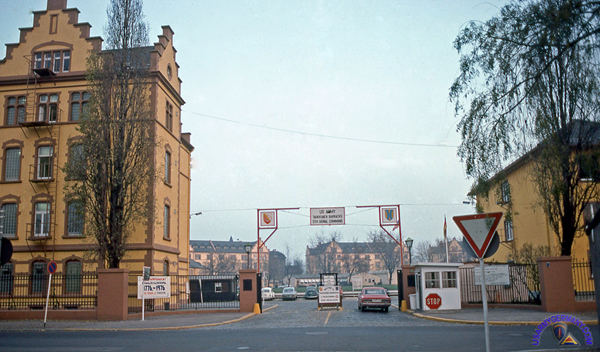
Main Gate, Taukkunen Barracks, Worms, 1976 (George Lane)
| Click on image to view a larger resolution of the map and access information on the location of units and facilities at Taukkunen Barracks in the early 1960s. Webmaster requests additional information on units and activities at Taukkunen and other Worms-Weiherhof installations during the 1945-1990 period. |
| Kemmel Kaserne in Worms was taken over by the French forces in 1945 and used as a military installation, under the name of Foch Caserne, until the Fall of 1951. American troops replaced the French and remained there until (1996). The name of the installation was changed to Taukkunen Barracks in October 1956. |
|
| History of Kemmel Kaserne/Taukkunen Barracks - in German only; go to the "Fotos und Grundriss aus dem Jahre 1999" link to see photos of the conversion. Kriegsfeld Special Weapons Depot - North Point - Ron Buckholz has a web site that focuses on the special weapons depot at Kriegsfeld and the units that operated the depot. Great photos and several newsletters. |
